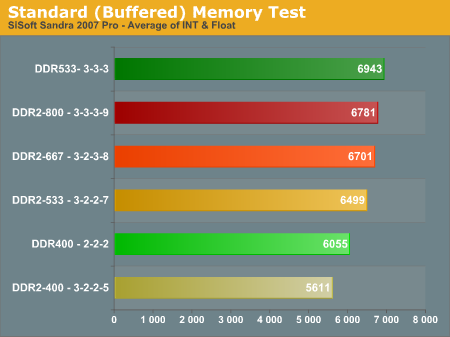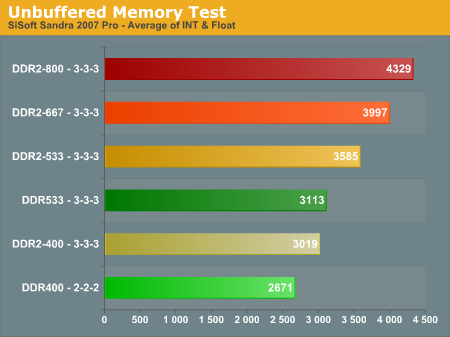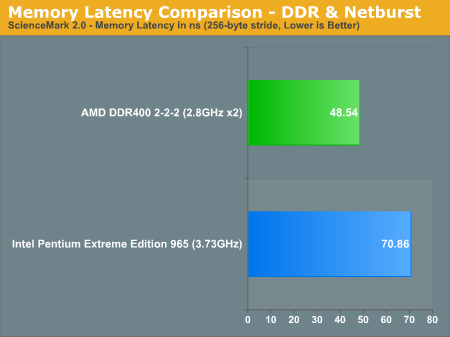DDR/NetBurst Memory Bandwidth and Latency
One of the most talked-about AMD advantages of the last couple of years has been their on-processor memory controller. This has allowed, according to popular theories, the Athlon64 to significantly outperform Intel NetBurst processors. The fact is NetBurst DDR2 bandwidth has recently been similar or wider in bandwidth than Athlon64 - even when the DDR is overclocked. You can see this clearly when we compare Buffered and Unbuffered Bandwidth of a NetBurst 3.46EE to an AMD 4800+ x2(2.4GHz, 2x1MB Cache) running DDR400 2-2-2 and running overclocked memory at DDR533 3-3-3.
The green bars represent DDR memory performance, while the beige to red are increasing DDR2 speed on NetBurst. Light green represents DDR400 2-2-2 while Dark Green is overclocked memory at the same CPU speed, DDR533 at 3-3-3.

In buffered performance, Fast DDR400 is only faster than DDR2-400 and slower than DDR2-533, 667 and 800. Overclocked memory at DDR533 3-3-3 is faster than any of the DDR2 bandwidths on NetBurst.
The Sandra Unbuffered Memory Test, which turns off features that tend to artificially boost performance, is generally a better measure of how memory will behave comparatively in gaming. The same green for DDR applies here.

Without Buffering, DDR400 has the smallest bandwidth of tested memory speeds and timings. Even overclocking to DDR533 allows the DDR to barely beat DDR2-400. DDR2-533, 667, and 800 all have greater Unbuffered bandwidth than the DDR overclocked to 533. NetBurst DDR2 memory bandwidth is generally wider than the bandwidth supplied by DDR memory on Athlon64. Despite the wider bandwidth, the deep pipelines and other inefficiencies in the NetBurst design did not allow the NetBurst processors to outperform Athlon64. Keep this in mind later, when we look at AM2 and Core 2 Duo Memory Bandwidth.
Latency
The other area where AMD has had an advantage over NetBurst DDR2 performance is memory latency, the result of the on-processor memory controller. Comparison of the AMD DDR Memory controller and the Intel DDR2 Memory controller in the Intel chipset shows AMD DDR with latency about 35% lower than Intel NetBurst in Science Mark 2.0.

While memory bandwidth was very similar between AMD and NetBurst, the deep pipes of the NetBurst design still behaved as if they were bandwidth starved. On the other hand the AMD architecture made use of the bandwidth available and the much lower latency to outperform NetBurst across the board.
One of the most talked-about AMD advantages of the last couple of years has been their on-processor memory controller. This has allowed, according to popular theories, the Athlon64 to significantly outperform Intel NetBurst processors. The fact is NetBurst DDR2 bandwidth has recently been similar or wider in bandwidth than Athlon64 - even when the DDR is overclocked. You can see this clearly when we compare Buffered and Unbuffered Bandwidth of a NetBurst 3.46EE to an AMD 4800+ x2(2.4GHz, 2x1MB Cache) running DDR400 2-2-2 and running overclocked memory at DDR533 3-3-3.
The green bars represent DDR memory performance, while the beige to red are increasing DDR2 speed on NetBurst. Light green represents DDR400 2-2-2 while Dark Green is overclocked memory at the same CPU speed, DDR533 at 3-3-3.

In buffered performance, Fast DDR400 is only faster than DDR2-400 and slower than DDR2-533, 667 and 800. Overclocked memory at DDR533 3-3-3 is faster than any of the DDR2 bandwidths on NetBurst.
The Sandra Unbuffered Memory Test, which turns off features that tend to artificially boost performance, is generally a better measure of how memory will behave comparatively in gaming. The same green for DDR applies here.

Without Buffering, DDR400 has the smallest bandwidth of tested memory speeds and timings. Even overclocking to DDR533 allows the DDR to barely beat DDR2-400. DDR2-533, 667, and 800 all have greater Unbuffered bandwidth than the DDR overclocked to 533. NetBurst DDR2 memory bandwidth is generally wider than the bandwidth supplied by DDR memory on Athlon64. Despite the wider bandwidth, the deep pipelines and other inefficiencies in the NetBurst design did not allow the NetBurst processors to outperform Athlon64. Keep this in mind later, when we look at AM2 and Core 2 Duo Memory Bandwidth.
Latency
The other area where AMD has had an advantage over NetBurst DDR2 performance is memory latency, the result of the on-processor memory controller. Comparison of the AMD DDR Memory controller and the Intel DDR2 Memory controller in the Intel chipset shows AMD DDR with latency about 35% lower than Intel NetBurst in Science Mark 2.0.

While memory bandwidth was very similar between AMD and NetBurst, the deep pipes of the NetBurst design still behaved as if they were bandwidth starved. On the other hand the AMD architecture made use of the bandwidth available and the much lower latency to outperform NetBurst across the board.










118 Comments
View All Comments
sld - Tuesday, July 25, 2006 - link
Yes I second the importance of a 32M run, because I want to know how Core 2 Duo does when the dataset does not fit into the L2 cache. The Intel fanboys at xtremesystems are annoying me with their whoops of glee over the 1M and 2M results.The performance difference in games and superpi is large enough to be termed anomalous, simply because superpi is a feel-happy benchmark.
Calin - Tuesday, July 25, 2006 - link
I've had the same issue on understanding the graphic - but I think it is much better now (top representing better performance, with the scale inverted)Anyway, great article!
As for the increases in cache helping AMD processors, I guess not - considering the small difference from 512k to 1M.
mattsaccount - Tuesday, July 25, 2006 - link
Never mind, I'm tired :)goinginstyle - Tuesday, July 25, 2006 - link
Page 7 is going to upset a lot of AMD fans.Page 9 index description needs to be "conclusion".
Great article and would love to see this comparison with the E6600 and E6300 CPUs against the competing AMD cpus. A lot of us will be buying these two processors and probably plain DDR2800.
OcHungry - Tuesday, July 25, 2006 - link
Can I ask you what memory timings you used?Since you have stated that memory speed does not affect conroe, would it be fair to assess that you used tightest timings for AM2?
If not: why?
About what page is going to make AMD users upset or hate the page, I totally disagree with you. You actually brought some lights to the whole scheme of things, unintentionally and unknowingly. You have helped to prove that Conroe will only be a mere 1 or 2% faster than AM2, which is not noticeable in real life situation. Conroe is only faster in Spi- But again, AMD beats Intel in memory bandwidth by a great margin. Memory bandwidth is much more important than SPI in terms of game and general cpu task(s). I will prove to everyone, that AMD is just as fast as conroe and post my reasoning in the cpu section, as soon as I have analyzed your benchmark data and made my calculations. But I need to know what memory timings you did use thu. A screenshot of timings would be great.
Again, thank you for this review that helped us open our eyes and see things in a better perspective.
Gary Key - Tuesday, July 25, 2006 - link
Wes replied earlier in the comments section but the settings are now posted on page 4 of the review.
goinginstyle - Tuesday, July 25, 2006 - link
Caluclations? I would like to see your benchmarks on actual hardware and not some scribbling on your Happy Meal napkin. I can caluclate that you are an idiot but really do not have the time to do it since I have a real life.
zsdersw - Tuesday, July 25, 2006 - link
1 or 2% faster? Please share with the rest of us what you're smoking.
Conroe is significantly faster on almost all fronts... in spite of having lower memory bandwidth.
Calin - Wednesday, July 26, 2006 - link
I suggest you to use a tractor and two trailers - one for persons and one for cargo. Even if you won't go faster than people with cars, you will have a huge bandwidth (persons and cargo bandwidth).If you buy your processor for bandwidth, choose whatever you want. If you buy it for speed, buy based on actual performance
bob661 - Tuesday, July 25, 2006 - link
I thought you didn't care about this stuff?